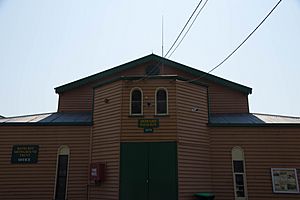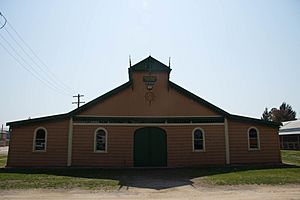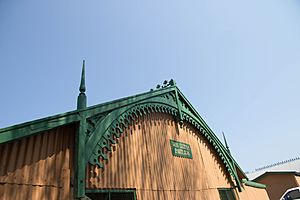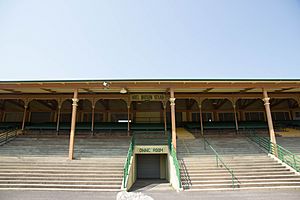Bathurst Showground facts for kids
Quick facts for kids Bathurst Showground |
|
|---|---|
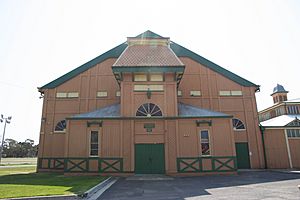
The Beau Brown Pavilion, built in 1892
|
|
| Location | Kendall Avenue (Great Western Highway), Bathurst, Bathurst Region, New South Wales, Australia |
| Built | 1879– |
| Architect |
|
| Owner |
|
| Official name: Bathurst Showground; Bathurst Showgrounds | |
| Type | State heritage (complex / group) |
| Designated | 4 September 2015 |
| Reference no. | 1960 |
| Type | Showground |
| Category | Community Facilities |
| Builders | Various |
| Lua error in Module:Location_map at line 420: attempt to index field 'wikibase' (a nil value). | |
The Bathurst Showground is a special place in Bathurst, Australia. It's listed as a heritage site, meaning it's important to history. People like James Hines and Edward Gell helped design it. It has been used for shows since 1879. The showground is owned by the Bathurst Showground Trust and the New South Wales government. It was added to the New South Wales State Heritage Register in 2015.
Contents
A Look Back: History of the Showground
The Bathurst Showground has a long and interesting past. It tells a story of the land, the people, and how farming changed over time.
Early Days: Indigenous People and Settlers
Long before European settlers arrived, the Wiradjuri people lived in the Macquarie Valley, where Bathurst is now. Their land stretched far and wide. When European settlers came, there were conflicts. Governor Brisbane even declared martial law in 1824. A Wiradjuri leader named Windradyne was famous for his resistance. However, some families, like the Suttors, tried to keep friendly relations with the Wiradjuri.
Farming in Bathurst: Growing the Region
Bathurst was the first European settlement inland from Sydney. Governor Macquarie officially started it in 1815. He wanted small farms to grow wheat. But soon, raising cattle and sheep became more important. Even so, many flour mills opened in Bathurst. The railway arrived in 1876, making it easier to send goods to Sydney.
Fruit farming also grew in the area. The Bathurst Experiment Farm started in 1895. After World War I, many soldiers became farmers, which helped the fruit industry grow even more. A cannery, Gordon Edgell & Sons, opened in 1926.
The Show Begins: Bringing People Together
In 1860, the first farming society started in O'Connell, near Bathurst. People wanted to encourage new farming methods. They hoped farmers would use new tools like winnowers (machines that separate grain) and thrashers (machines that separate seeds from plants).
The shows also helped people in the region meet up and socialize. A reporter in 1921 said the show united people like nothing else. It offered many fun social activities over the years.
First Shows and New Locations
The O'Connell show was very popular. It featured contests for animals, crops, and farm tools. After a few successful shows, people from Bathurst decided to form their own association in 1862. It became the Bathurst Agricultural, Horticultural and Pastoral Association.
The show moved around a bit. It was held at "Alloway Bank" in 1863. Then, land was bought in Raglan, east of Bathurst. The show stayed there until 1868, when it moved to the Bathurst racecourse.
Finally, in 1878, the show found its permanent home. A large piece of land was granted by the government. This land had been used for cattle markets since 1833. The show has been held there ever since!
Growing the Showground
More land was added in 1888 and 1890, making the showground much bigger. Fences were built, trees were planted, and new animal stalls were put up. A trotting track was also created. Planting trees was very important, partly because it was required and partly because it made the showground look beautiful. An architect named Edward Gell even gave advice on the plantings.
The show grew from one day to two days in 1878, and then to three days by 1883. This allowed more time for selling farm products and showing off the best livestock.
New Ideas and Technologies
The Bathurst Show was a great place to see new inventions. In 1876, people were amazed by Mrs. J. Rutherford's preserves, which kept fruit fresh for a long time. Later, the show introduced the first rotary disc ploughs, irrigation pumps, milk separators, and shearing equipment to the area. Even bicycle races were added in 1883!
The railway helped the show a lot. The train company even offered cheaper tickets for people traveling to the show. This brought visitors from far away, like Sydney and Orange. Important people, like governors and premiers, often opened the show, showing how respected it was.
Challenges and Changes Over Time
Attendance dropped in 1904 when train discounts stopped. But when discounts returned in 1908, more people came.
World Wars and Flu Epidemic
During World War I, the showground was used as a military camp in 1916. A flood in October 1916 and the army's use left the grounds in poor condition. So, no show was held in 1917.
In 1919, the government stopped large gatherings because of the influenza epidemic. Shows continued from 1920 until 1942, when the Defence Department again used the showground as a training camp during World War II. The show didn't return until 1946.
Entertainment and Social Life
The show always had fun entertainment. Circuses like Probasco's and Wirth's visited. Many traveling carnival families loved the Bathurst Show because it was so profitable. Some families have returned for over 100 years!
Concerts and dances also became popular. A "Smoking Evening" for men was very successful in 1923. These events helped raise money for the showground. However, during the Great Depression in the 1930s, many extra shows were stopped. Even then, the show was a chance for people from the countryside to relax and meet friends.
Post-War Growth
After World War II, the Bathurst Show became even more famous. It was said to be second only to the Sydney Royal Easter Show. In 1965, night displays began under new floodlights. The 100th show was celebrated in 1968.
In the late 1970s, the trotting track was improved. This led to a new race, the Gold Crown, which first ran in 1987. In 1986, a flood caused a lot of damage, requiring major repairs.
To celebrate its 125th show in 1993, the Association was allowed to add "Royal" to its name.
Key Developments and Dates
Many changes and additions have been made to the showground over the years:
- 1878 – First show on the current grounds.
- 1879 – The Howard Pavilion, the first permanent building, was built.
- 1882 – Gas lighting was installed in the Howard Pavilion for night events.
- 1883 – Sinclair Pavilion was built.
- 1885 – Caretaker's house and Don Leitch Pavilion were built, along with animal pens.
- 1888 – More land was leased from Bathurst City Council.
- 1889 – Fencing, tree planting, and a half-mile trotting track were added.
- 1891 – More land was granted. A poultry shed became an agricultural hall.
- 1891-2 – The Grandstand and Art Gallery (Beau Brown Pavilion) were moved from Ashfield and rebuilt here.
- 1893 – Electric light was installed.
- 1898 – Trevitt Pavilion was built.
- 1916, 1 January – Military used the showground, causing some changes.
- c. 1924 – Showground connected to sewerage and electricity.
- 1940, 3 April – Sam Williams Memorial Gates were built.
- 1942-5 – Military used the showground again.
- 1952 – Noel Moxton Grandstand was painted. Prior Cattle Pavilion built.
- 1954, 14 November – Night trotting began with new lighting.
- 1965 – New floodlights were installed in the arena.
- 1966 – Major renovations to Noel Moxton grandstand and Howard Pavilion.
- 1975 – The Owens Stand opened.
- 1986, 5–6 August – Showground flooded, causing damage.
- 1987 – Major repair work on Beau Brown Pavilion.
- 1991 – Ron Wood Stable Complex was finished.
What the Showground Looks Like Today
The Bathurst Showground is located at the edge of the city. It's bordered by Kendall Avenue, the Macquarie River, and Vale Creek. The main part of the showground is a gravel race track with a grassy arena in the middle.
Trees and Plants
Many trees were planted starting in 1878. These included English elm, ash, pine, cypress, black locust, and Osage orange. Some of these old trees are still there today. They help make the showground beautiful and fit in with the landscape.
Important Buildings
There are about 35 buildings at the showground, built from 1879 onwards. They are made of different materials like timber, iron, and brick. But they all work together to create a classic "fairground" look.
The Beau Brown Pavilion
This is the biggest enclosed building at the showground. It started its life in Sydney around 1886 as a skating rink. In 1892, it was bought and moved to Bathurst. It was also known as the Art Gallery. In 1967, it was renamed to honor Mr. B. A. Brown. It had major repairs in 1987.
The building has a timber frame and a large open space inside. Its unique look comes from its central entrance porch and a small tower with a pyramid-shaped roof. The tower has cool decorations like fish-scale metal tiles and lion heads.
The Trevitt Pavilion
This pavilion was built in 1897 as a place for poultry (chickens, ducks, etc.). It was designed by J.J. Copemen. It was named after Mr. Ken Trevitt in 1952.
The building has a high central section with a hipped roof and a clerestory (a row of windows above the main roof). It has a large cupola (a small dome-like structure) on its roof, which once held a flagpole.
The Howard Pavilion
This was the first big building at the showground, built in 1879. It was designed by Edward Gell. It was named around 1957 after James Howard, who served the show for a long time.
It's a timber-framed building with a main gabled roof and lower side roofs. It has a rounded end with an entrance door. The walls are made of wooden weatherboards. The roof has decorative cast iron on top.
The CEC English Pavilion
This building was built in 1886 and designed by James Hine. It was named after C. E. C. English, a long-serving show steward. It has a traditional timber frame with gabled roofs facing north and south. It also has a monitor roof, which is a raised section with windows for light.
The outside is very handsome, with decorative timberwork and different types of wooden wall coverings. It has double doors and rounded windows.
Sinclair Pavilion
This was the second major building, ready for the 1883 show. It was built to hold 150 pens for sheep. It was named after a dedicated show steward after 1967 and still serves its original purpose.
It's a long, narrow building with a low-pitched roof. The north end has decorative timberwork and a central finial (a decorative top piece) on the roof.
The Don Leitch Pavilion
Designed by James Hine and built in 1885, this building was first used for pigs and was nicknamed "The Palace" because of its fancy decorations. It was named after Don Leitch, a long-serving president of the show society.
It's a rectangular building with a unique "broken-back" roof shape. The ends have distinctive decorative gables.
Prior Pavilion
This simple, traditional building was built in 1952. It has a timber frame and a broad gabled iron roof. It's partly open and partly covered with vertical wooden boards. Its design is different from older pavilions, possibly because building materials were hard to find after the war.
Cattle Pens A
This is a long, narrow structure built in 1914. It's made of rough timber and corrugated iron. One side is open with removable wooden rails. It shows a simple, traditional way of building for livestock, which is a unique Australian style.
Noel Moxon Stand
This grandstand was bought and moved from Ashfield in 1891 and was ready for the 1892 show. It's a late Victorian style grandstand with a timber-framed roof and concrete steps. Some of its original decorative ironwork is still there.
Gatekeeper's Lodge
This small cottage was built in 1885. It has a unique, charming design with colorful brickwork. It's a two-story building with a T-shape and a distinctive roof. It was designed by James Hine, an important Bathurst architect.
Outdoor Bar
This building was originally two "booths" for lunch, with space for a bar. Now, only one remains, and its walls have been removed. It's supported by wooden posts.
The Arena
The arena is about 300 meters long and 120 meters wide. The gravel track around it is 18 meters wide and 810 meters long. The grassy arena, surrounded by elm trees, is a key part of the showground.
The arena has been the center of show activities since 1888. It hosts horse events, competitions, and even special demonstrations. The first airplane flight in the central west region was seen here in 1912! Trotting races have been popular since 1889, and night trotting started in 1953.
Why the Showground is Important
The Bathurst Showground is very important to the history and culture of New South Wales.
It shows how important farming was to the state's growth. The Bathurst Show became known as one of the best agricultural shows in NSW. This showed how successful farming was in the region and how proud locals were of their products.
The showground has been used continuously since 1878, making it one of the oldest showgrounds still in use. It also has some of the earliest showground buildings, like the Howard Pavilion from 1879.
The buildings and landscape of the showground are also very beautiful. Architects carefully designed the buildings and planned the tree plantings. This makes the showground a landmark in Bathurst. Along with places like Glen Innes and Singleton Showgrounds, Bathurst has some of the best and most complete showground buildings in NSW.
The showground is a great example of how agricultural shows help rural communities. They bring people together and help spread new farming ideas and technologies. The Bathurst Showground has attracted people from all over, including Sydney, Lithgow, and Orange. It was a big social event where people could meet old friends.
The Bathurst Showground is also special because it has so many original buildings that are still in good condition. Many other showgrounds have lost their old buildings. Bathurst, along with Singleton, Maitland, and Glen Innes, has kept a wide variety of its historic buildings. New buildings have also been designed to fit in with the old ones.



